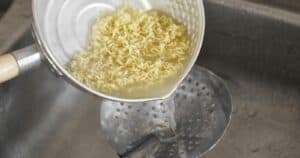Nothing satisfies hunger quite like steaming hot ramen noodles. But can you really just pop that styrofoam cup in the microwave for a quick meal? Think again! Microwaving ramen in styrofoam poses major health risks that are absolutely not worth the convenience.
In this guide, we’ll explain why microwaving ramen in styrofoam is dangerous. Heating styrofoam releases toxic chemicals like styrene, which can cause anything from dizziness to increased cancer risk with regular exposure.
We’ll also share quick, easy and eco-friendly ways to cook ramen safely using the stovetop, kettle, or reusable microwave-safe containers. With these simple alternatives, you can enjoy delicious ramen in minutes without putting your health at risk.
You’ll learn:
- Why styrofoam releases toxic styrene gas when microwaved
- The dangerous short and long-term health effects of ingesting styrene
- Safer methods for cooking ramen quickly at home
- Eco-friendly tips for reducing waste while enjoying ramen
Microwaving ramen in styrofoam may seem like an easy shortcut, but it’s simply not worth risking your health and safety. Keep reading to cook ramen the right way!
Why Does Microwaving Ramen in Styrofoam Release Toxins?
Styrofoam is made from expanded polystyrene (EPS) foam. It contains styrene, a hazardous chemical that can leach into food when heated. Here’s why microwaving styrofoam is dangerous:
Styrene Vapors are Toxic
When heated, styrofoam releases styrene in vapor form. Styrene vapors can cause:
- Dizziness
- Headaches
- Difficulty with balance
With prolonged exposure, styrene may also lead to cancer.
Danger to Pets’ Respiratory Systems
The styrene vapors released when microwaving styrofoam are especially risky for household pets. Animal respiratory systems are highly sensitive.
Melting Poses Contamination Risk
In the microwave, styrofoam’s low melting point causes containers to melt. This releases toxic fumes and makes food surfaces unsuitable for eating.
Highly Flammable
Heated styrofoam can easily catch fire, putting you at risk and potentially damaging the microwave.
It’s clear that microwaving ramen in styrofoam puts your health at risk. Next, let’s explore the dangers in more detail.
The Serious Health Dangers of Microwaving Ramen in Styrofoam
Heating styrofoam in the microwave can have lasting negative health effects. Here are some of the top concerns:
Increased Cancer Risk from Styrene
With regular exposure, the styrene released from microwaved styrofoam may increase cancer risk. Long-term ingestion is particularly hazardous.
Immediate Symptoms Like Dizziness and Fatigue
After eating ramen heated in styrofoam, you may experience immediate symptoms like:
- Dizziness
- Headaches
- Difficulty concentrating
- Fatigue
These symptoms stem from ingesting the released styrene.
Harm to Respiratory and Digestive Systems
For both humans and animals, the vapors can irritate respiratory systems. And ingesting melted styrene can inflame digestive systems.
Fire Hazard
Heated styrofoam can easily ignite, putting your safety at risk. Fires can also damage the microwave itself.
Rather than risking these dangers, choose a safer method to cook your ramen. Up next, we’ll explore quick and easy alternatives.
Safe, Toxin-Free Ramen Cooking Alternatives
You can enjoy hot ramen noodles in minutes without ever microwaving them in styrofoam. Here are safe ideas:
Use the Stovetop
Boil water in a pot, add noodles and cook 2-3 minutes. Add seasonings after draining.
Try a Microwave-Safe Bowl
Transfer ramen to a glass or ceramic bowl. Add water, microwave 3 minutes, then season.
Opt for an Electric Kettle
Boil water in a kettle. Pour over noodles in a bowl, cover and let sit 3-4 minutes.
Pan Fry for Crispy Noodles
Boil briefly, drain, then pan fry in oil 2-3 minutes until crispy. Toss with seasonings.
Reuse Containers
Cook in reusable glass or ceramic dishes instead of disposable materials.
These methods create delicious ramen free of toxins! For even more flavor, add proteins, veggies, herbs and spices.
Eco-Friendly Ramen Tips for Reducing Waste
You can also make green choices when cooking and eating ramen to reduce environmental impact:
- Use reusable containers instead of disposable styrofoam cups
- Opt for reusable utensils like bamboo chopsticks over plastic
- Cook ramen in a reusable pot on the stove
- Flavor ramen with reusable ingredients like sesame oil, soy sauce and lime
- Compost any food scraps like vegetable peels or eggshells
With small tweaks, you can enjoy ramen while minimizing waste!
Microwaving ramen in styrofoam may seem quick and convenient. But toxins like styrene can leach into foods and pose major health risks ranging from dizziness to increased cancer risk.
Instead, try safer cooking methods using the stovetop, kettle, microwave-safe bowls or reusable containers. You’ll get delicious ramen in minutes without endangering your health. Pair these smart tips with eco-friendly practices, and ramen can become a quick, safe and waste-free meal!





